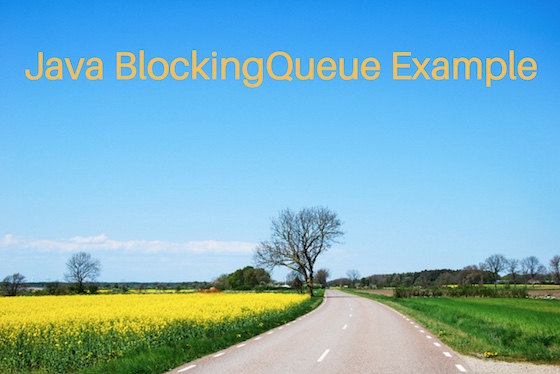Today we will look into Java BlockingQueue. java.util.concurrent.BlockingQueue is a java Queue that support operations that wait for the queue to become non-empty when retrieving and removing an element, and wait for space to become available in the queue when adding an element.
Java BlockingQueue
 Java BlockingQueue doesn’t accept
Java BlockingQueue doesn’t accept null values and throw NullPointerException if you try to store null value in the queue. Java BlockingQueue implementations are thread-safe. All queuing methods are atomic in nature and use internal locks or other forms of concurrency control. Java BlockingQueue interface is part of java collections framework and it’s primarily used for implementing producer consumer problem. We don’t need to worry about waiting for the space to be available for producer or object to be available for consumer in BlockingQueue because it’s handled by implementation classes of BlockingQueue. Java provides several BlockingQueue implementations such as ArrayBlockingQueue, LinkedBlockingQueue, PriorityBlockingQueue, SynchronousQueue etc. While implementing producer consumer problem in BlockingQueue, we will use ArrayBlockingQueue implementation. Following are some important methods you should know.
put(E e): This method is used to insert elements to the queue. If the queue is full, it waits for the space to be available.E take(): This method retrieves and remove the element from the head of the queue. If queue is empty it waits for the element to be available.
Let’s implement producer consumer problem using java BlockingQueue now.
Java BlockingQueue Example – Message
Just a normal java object that will be produced by Producer and added to the queue. You can also call it as payload or queue message.
package com.journaldev.concurrency;
public class Message {
private String msg;
public Message(String str){
this.msg=str;
}
public String getMsg() {
return msg;
}
}
Java BlockingQueue Example – Producer
Producer class that will create messages and put it in the queue.
package com.journaldev.concurrency;
import java.util.concurrent.BlockingQueue;
public class Producer implements Runnable {
private BlockingQueue<Message> queue;
public Producer(BlockingQueue<Message> q){
this.queue=q;
}
@Override
public void run() {
//produce messages
for(int i=0; i<100; i++){
Message msg = new Message(""+i);
try {
Thread.sleep(i);
queue.put(msg);
System.out.println("Produced "+msg.getMsg());
} catch (InterruptedException e) {
e.printStackTrace();
}
}
//adding exit message
Message msg = new Message("exit");
try {
queue.put(msg);
} catch (InterruptedException e) {
e.printStackTrace();
}
}
}
Java BlockingQueue Example – Consumer
Consumer class that will process on the messages from the queue and terminates when exit message is received.
package com.journaldev.concurrency;
import java.util.concurrent.BlockingQueue;
public class Consumer implements Runnable{
private BlockingQueue<Message> queue;
public Consumer(BlockingQueue<Message> q){
this.queue=q;
}
@Override
public void run() {
try{
Message msg;
//consuming messages until exit message is received
while((msg = queue.take()).getMsg() !="exit"){
Thread.sleep(10);
System.out.println("Consumed "+msg.getMsg());
}
}catch(InterruptedException e) {
e.printStackTrace();
}
}
}
Java BlockingQueue Example – Service
Finally we have to create BlockingQueue service for producer and consumer. This producer consumer service will create the BlockingQueue with fixed size and share with both producers and consumers. This service will start producer and consumer threads and exit.
package com.journaldev.concurrency;
import java.util.concurrent.ArrayBlockingQueue;
import java.util.concurrent.BlockingQueue;
public class ProducerConsumerService {
public static void main(String[] args) {
//Creating BlockingQueue of size 10
BlockingQueue<Message> queue = new ArrayBlockingQueue<>(10);
Producer producer = new Producer(queue);
Consumer consumer = new Consumer(queue);
//starting producer to produce messages in queue
new Thread(producer).start();
//starting consumer to consume messages from queue
new Thread(consumer).start();
System.out.println("Producer and Consumer has been started");
}
}
Output of the above java BlockingQueue example program is shown below.
Producer and Consumer has been started
Produced 0
Produced 1
Produced 2
Produced 3
Produced 4
Consumed 0
Produced 5
Consumed 1
Produced 6
Produced 7
Consumed 2
Produced 8
...
Java Thread sleep is used in producer and consumer to produce and consume messages with some delay.
Source:
https://www.digitalocean.com/community/tutorials/java-blockingqueue-example













